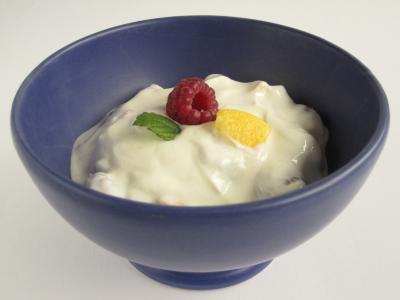
Health Benefits of Yogurt
Yogurt comes from milk. So you get a good source animal protein (about 9 grams per 6-ounce serving), plus several other nutrients found in dairy foods, like calcium, vitamin B-2, vitamin B-12, potassium, and magnesium. It also contains valuable probiotics which are “friendly bacteria” that are naturally present in the digestive system. Live strains of these “good bacteria” can help boost the immune system and promote a healthy digestive tract.
It doesn’t contain all the same beneficial bacteria as kefir, nor are there as many. But you can’t beat it for a great substitute for sour cream; and frozen yogurt is a yummy substitute for ice cream. Sweetened with a little honey or Stevia, and an addition of your favorite fruit, makes it a great snack. It’s even great with a few chopped nuts sprinkled on top.
Make Your Own Yogurt
Making your own yogurt is more economical than buying it, plus you get the added benefit of culturing longer which increases the probiotics content. If at all possible I like making my yogurt from raw milk which comes from free grazing grass fed dairy cows.
There are several ways to make yogurt, but using a crock pot is my favorite method. It takes less of my time. (You may also warm milk up in a stainless steel pan until it reaches 185 degrees and then continue as directed below).
First you will need:
- 1 crock pot (one that has a separate bowl from the heating mechanism)
- 1 gallon of milk (it can be any kind but I prefer raw)
- 1 carton of your favorite plain yogurt with “live cultures”
- Candy thermometer
- Whisk
Directions:
Pour 1 gallon of milk into your crock pot. Turn on high setting.
- In about 4 hours the temperature will reach 185 degrees. Check this with your candy thermometer.
- Once it reaches this temperature, take the bowl of yogurt out of the heating mechanism and place it in the sink filled with ice water. Take the lid off and stir occasionally until the temperature reaches 110 to 115 degrees.
- When it reaches this perfect temperature add the carton of plain yogurt and whisk.
- Put the lid back on your bowl of milk and yogurt and place in a warm spot. I like to warm up my oven to 170 degrees and then turn it off to give it a good place to start culturing.
- Keep the yogurt in this warm environment for 24 hours. Generally, yogurt doesn’t like to be disturbed while it is culturing, so leave it alone and try not to move it around.
- When your yogurt is cultured you can then choose to do many things with it. Add Stevia or honey to sweeten it if you like. Add fruit or nuts. Make a batch of frozen yogurt with it. Use it for sour cream in your favorite recipes, etc.
- If you want Greek yogurt you can strain it through a strainer covered in cheese cloth. The only difference between regular yogurt and Greek yogurt is this process.
- If you strain it even longer you can make yogurt cheese. Add your favorite seasonings and/or use it like cream cheese.
Health Benefits of Greek Yogurt:
Low lactose levels: Greek yogurt has lower lactose levels than regular yogurt, making it a better choice for lactose intolerant individuals. The incubating process also creates bacterial cultures which provide enzymes that contribute to better digestion of lactose.
Higher protein content: On average a cup of Greek yogurt has 20 grams of protein and only 8 grams of carbohydrate compared to plain, low-fat yogurt at 12 grams protein and 7 grams of carbohydrate.
Weight loss: Studies have indicated that eating yogurt will help with weight loss. Because of the higher protein content of Greek yogurt you can eat less and feel fuller longer making it an even better choice if you’re watching what you eat.
